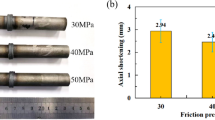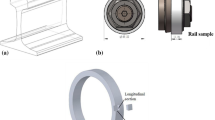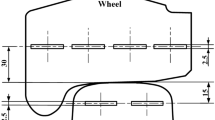Abstract
Brittle fracture occurs frequently in rails and thermite welded joints, which intimidates the security and reliability of railway service. Railways in cold regions, such as Qinghai-Tibet Railway, make the problem of brittle fracture in rails even worse. A series of tests such as uniaxial tensile tests, Charpy impact tests, and three-point bending tests were carried out at low temperature to investigate the mechanical properties and fracture toughness of U71Mn and U75V rail steels and their thermite welds. Fracture micromechanisms were analyzed by scanning electron microscopy (SEM) on the fracture surfaces of the tested specimens. The ductility indices (percentage elongation after fracture and percentage reduction of area) and the toughness indices (Charpy impact energy A k and plane-strain fracture toughness K IC) of the two kinds of rail steels and the corresponding thermite welds all decrease as the temperature decreases. The thermite welds are more critical to fracture than the rail steel base metals, as indicated by a higher yield-to-ultimate ratio and a much lower Charpy impact energy. U71Mn rail steel is relatively higher in toughness than U75V, as demonstrated by larger A k and K IC values. Therefore, U71Mn rail steel and the corresponding thermite weld are recommended in railway construction and maintenance in cold regions.
Similar content being viewed by others
References
N. Ilić, M.T. Jovanović, M. Todorović, and P. Šaponjić, Microstructural and mechanical characterization of postweld heat-treated thermite weld in rails, Mater. Charact., 43(1999), No.4, p.243.
Y. Terashita and M. Tatsumi, Analysis of damaged rail weld, Q. Rep. RTRI, 44(2003), No.2, p.59.
P.J. Mutton and E.F. Alvarez, Failure modes in aluminothermic rail welds under high axle load conditions, Eng. Failure Anal., 11(2004), No.2, p.151.
Y. Chen, F.V. Lawrence, C.P.L. Barkan, and J.A. Dantzig, Weld defect formation in rail thermite welds, Proc. Inst. Mech. Eng. Part F, 220(2006), No.4, p.373.
F.V. Lawrence, E.T. Ross, and C.P.L. Barkan, Reliability of Improved Thermite Welds, Final report for high-speed rail IDEA project 41, University of Illinois at Urbana Champaign, 2004.
W.N. Zhang, F.M. Xu, and Y. Tan, Species characteristic and formation of microdefect in accept thermite weld joint in rails, Mater. Mech. Eng., 31(2007), No.11, p.40.
S.F. Gao, C.L. Cui, J.J. Chi, B.X. Wang, and D.H. Qiu, Development of CARS ZTK-I 60 kg·m−1 rail alumino-thermit welding consumables, China Railw. Sci., 29(2008), No.6, p.135.
B.R. Feng, Y.Q. Wang, Y.J. Shi, and Y.M. Wu, Analysis on fracture accidents and its influencing factors for steel tracks in China, Low Temp. Archit. Technol., 27(2005), No.4, p.97.
Y.Q. Wang, W. Xi, and Y.J. Shi, Experimental study of the impact toughness of rail steel at low temperatures, J. Tsinghua Univ. Sci. Technol., 47(2007), No.9, p.1414.
Z.B. Hu, L. Li, L.S. Zou, L.X. Li, and M. Zhu, TB/T 1632.3-2005, Welding of Rails Part 3: Thermit Welding, China Railway Press, Beijing, 2005.
X.B. Liang, J.L. Li, L.Y. Tao, H.P. Li, and Z.Y. Gao, GB/T 228-2002, Metallic Materials: Tensile Testing at Ambient Temperature, China Standard Press, Beijing, 2002.
Y. Li, Y.F. Gao, T. Liu, F.S. Wang, Z.M. Sun, and B. Wang, GB/T 13239-2006, Metallic Materials: Tensile Testing at Low Temperature, China Standard Press, Beijing, 2006.
Y.M. Wu, Y.Q. Wang, Y.J. Shi, and J. Jiang, Effects of low temperature on properties of structural steels, J. Univ. Sci. Technol. Beijing, 11(2004), No.5, p.442.
M.R. Zhang and H.C. Gu, Microstructure and mechanical properties of railway wheels manufactured with low-medium carbon Si-Mn-Mo-V steel, J. Univ. Sci. Technol. Beijing, 15(2008), No.2, p.125.
D.L. Ren, F.R. Xiao, P. Tian, X. Wang, and B. Liao, Effects of welding wire composition and welding process on the weld metal toughness of submerged arc welded pipeline steel, Int. J. Miner. Metall. Mater., 16(2009), No.1, p.65.
Z.H. Jiang, Z.R. Zhang, H.B. Li, Z. Li, and Q.F. Ma, Microstructural evolution and mechanical properties of aging high nitrogen austenitic stainless steels, Int. J. Miner. Metall. Mater., 17(2010), No.6, p.729.
L.M. Zhu, L.P. Gao, et al., GB/T 229-2007, Metallic Materials: Charpy Pendulum Impact Test Method, China Standard Press, Beijing, 2007.
Y.F. Gao, T. Liu, Y.D. Qing, R.F. Li, F.L. Ding, and C.X. Wang, GB/T 4161-2007, Metallic Materials: Determination of Plane-strain Fracture Toughness, China Standard Press, Beijing, 2007.
Author information
Authors and Affiliations
Corresponding author
Additional information
This work was financially supported by the Research Foundation of the Ministry of Railways and Tsinghua University (No.T200410) and the National Natural Science Foundation of China (Nos.50778102 and 51178244)
Rights and permissions
About this article
Cite this article
Wang, Yq., Zhou, H., Shi, Yj. et al. Mechanical properties and fracture toughness of rail steels and thermite welds at low temperature. Int J Miner Metall Mater 19, 409–420 (2012). https://doi.org/10.1007/s12613-012-0572-8
Received:
Revised:
Accepted:
Published:
Issue Date:
DOI: https://doi.org/10.1007/s12613-012-0572-8




